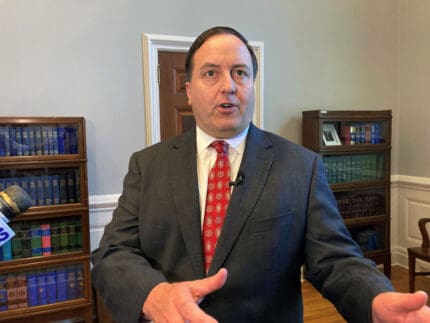DeSantis voted against increased funding for program now helping Floridians after Ian
The National Flood Insurance Program has approved more than $48 million for claims from policyholders in Florida.

The day after taking office as a member of Congress in 2013, Florida Republican Gov. Ron DeSantis voted against a bill authorizing the raising of the limit on borrowing by the Federal Emergency Management Agency to run the National Flood Insurance Program, which provides coverages to businesses and homeowners to help them recover after flooding has taken place. As the media outlet E&E News reported earlier this month, the bill passed and achieved its intended goal of increasing the cap on borrowed funds from $20.8 billion to $30.4 billion. Sixty-seven Republicans opposed it.
The NFIP provides affordable flood insurance to millions of people who cannot otherwise procure it due to the high-risk nature of their property resulting in high premiums from private insurers. Flood insurance is not typically included in homeowners’ policies. The program is funded by Congress, and must be renewed periodically; the deadline for the next reauthorization is Dec. 16 this year.
The vote to raise the debt limit in 2013 was prompted by Hurricane Sandy, a storm which caused huge amounts of damage, particularly in the northeastern United States, in October 2012 that National Geographic called “a raging freak of nature.” The flood insurance program subsequently paid out $8.6 billion in claims for properties spread among Connecticut, New York and New Jersey devastated by the superstorm. E&E News reported that the debt ceiling increase allowed the NFIP to cover 145,000 claims.
The Florida nonprofit Flood Defenders reported in August 2020 that the NFIP had underwritten 5.1 million insurance policies on $1.3 trillion worth of property and had paid $225 million on claims submitted in Florida alone in 2019.
The NFIP has been critical to helping Floridians recover in the wake of Hurricane Ian, which devastated parts of Florida’s coast last month. The NFIP page on FEMA’s website reports that in the second quarter of 2022, the program has $17.8 billion available to pay claims: $7.9 billion in reserves, plus $9.9 billion available to borrow.
However, that is not enough to cover the damage from Ian. Estimates vary, but one source suggests a range of property damage costs from $42 billion to $248 billion.
But without the increase in NFIP’s debt ceiling, according to the energy and environment website E&E News, the program would have only had $8.2 billion for claims payouts for storm damage across the county, which this year has included extensive flooding in multiple states in addition to damage caused by Hurricane Fiona in Puerto Rico in September.
On Oct. 13, FEMA announced, “As of Oct. 11, FEMA’s National Flood Insurance Program (NFIP) has received more than 35,000 flood insurance claims and paid more than $48 million to policyholders, including $35 million in advance payments” in the wake of Hurricane Ian. FEMA also extended the proof-of-loss requirement under the program from 60 to 365 days and offered up to $1,000 in coverage for supplies such as sandbags, lumber and temporary storage.
Published with permission of The American Independent Foundation.
Recommended

President Biden visits Prince William park to talk solar, youth involvement on Earth Day
Virginia set to receive $156 million from U.S. Environmental Protection Agency program
By Charlie Paullin, Virginia Mercury - April 23, 2024
Texas governor and attorney general do little to curb state’s chemical plant crisis
Republicans Greg Abbott and Ken Paxton have taken thousands of dollars in donations from chemical companies and their affiliated PACs.
By Jesse Valentine - December 08, 2023
‘We’ve been waiting for this’: Union workers cheer Biden’s hydrogen hub plan
Federal funding for the hub is estimated to bring over 20,000 jobs to the Pennsylvania-New Jersey-Delaware area.
By Anna Gustafson - October 17, 2023









































































